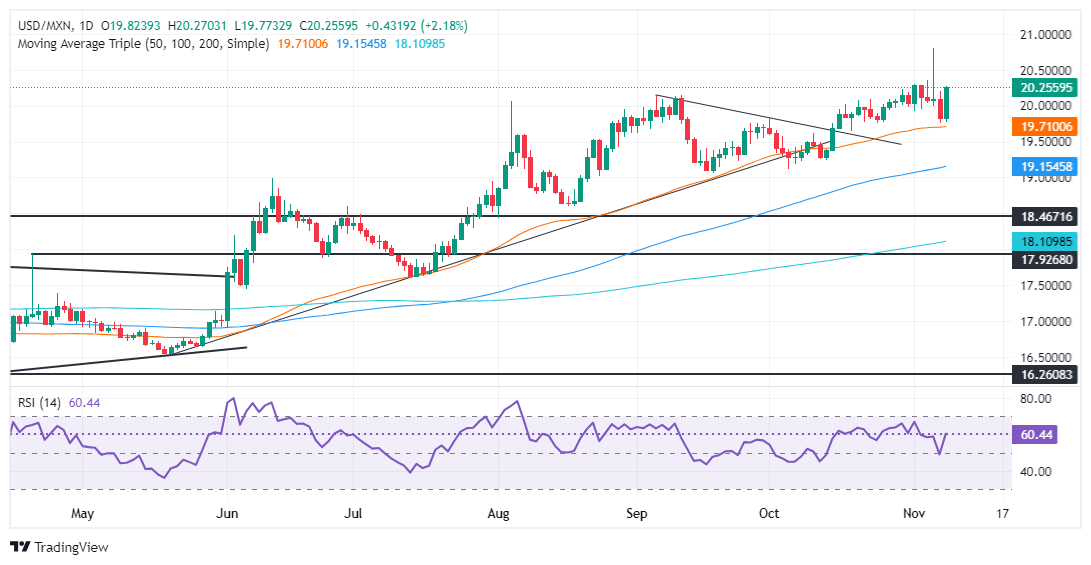Mexican Peso drops amid anxiety on Trump’s protectionism policies

- Mexican Peso weakens on fears of Trump-imposed tariffs on Mexican imports.
- Banxico expected to cut rates by 25 bps as inflation approaches 3% target.
- Upcoming US and Mexico economic data, including consumer confidence and Banxico decision, may add to Peso’s volatility.
The Mexican Peso is against the ropes versus the Greenback on Friday, with the latter recovering some ground even though the US Federal Reserve (Fed) cut rates on Thursday. Risk aversion sponsored by China’s lack of clarity on its program to stimulate the economy weighed on global equities, while traders continue to digest Trump’s victory for a third day. At the time of writing, the USD/MXN trades at 20.16, up more than 1.85%.
Mexico’s economic docket remains absent on Friday, but there’s some anxiety after Americans elected Donald Trump as their next president. Fears that Trump could impose tariffs on Chinese and Mexican imports, could spark a reacceleration of inflation and disrupt supply chains.
Mexico’s Economy Secretary Marcelo Ebrard commented on Thursday that most of Mexico’s imports from China are made by around 50 companies and most of them are American. “Putting a tariff on those imports will only put those companies in danger, starting with the automotive industry,” Ebrard said.
In the meantime, the Bank of Mexico (Banxico) is expected to lower rates by 25 basis points on its monetary policy next week. The chances of adjusting policy 50 basis points (bps) are remote, though the latest report showed that underlying inflation dipped from 3.91% to 3.80% YoY, closing into the 3% goal.
Recently in the US, the Consumer Sentiment for November was revealed by the University of Michigan (UoM). The index improved sharply, but inflation expectations in the near and long term were mixed.
On Thursday, the Fed lowered rates by 25 bps but failed to provide guidance moving forward. Fed Chair Jerome Powell and the Federal Open Market Committee (FOMC) voted unanimously. In Powell’s presser he added that the economy remains solid, the labor market has cooled somewhat, and that inflation made progress toward the 2% goal. Despite this, the US central bank hasn’t declared victory on high prices.
Next week, Mexico’s schedule will feature Consumer Confidence readings, Industrial Production and the Banxico policy decision. On the US front, Fed speakers, inflation on the consumer and the producer side and Retail Sales will dictate the US Dollar’s path moving forward.
Daily digest market movers: Mexican Peso collapses on downbeat mood
- The UoM Consumer Sentiment preliminary November reading improved from 70.5 to 73.0, a 3.5% increase. Survey Director Joanne Hsu revealed that, “While current conditions were little changed, the expectations index surged across all dimensions, reaching its highest reading since July 2021.”
- Inflation expectations for one-year dipped from 2.7% to 2.6%. For a five-year period, they inched up from 3.0% to 3.1%.
- Data from the Chicago Board of Trade, via the December fed funds rate futures contract, shows investors estimate 24.5 bps of Fed easing by the end of the year.
USD/MXN technical outlook: Mexican Peso tumbles again as USD/MXN rises above 20.00
As mentioned throughout the whole week, the USD/MXN bias is upwards, and the correction post-November 5 seems to be reversed. Sellers had lost steam, and buyers re-emerged at around 19.70, pushing the exotic pair above 20.00.
If buyers reclaim 20.50, the two-year peak hit at 20.80 would be exposed. Once those two levels are surpassed, 21.00 would be up next, followed by the March 8 peak at 21.46.
On the downside, sellers must regain the 20.00 figure, if they would like to challenge the 50-day Simple Moving Average (SMA) at 19.68. On further weakness, the next stop would be the psychological figures of 19.50, followed by the October 14 low of 19.23.
Risk sentiment FAQs
In the world of financial jargon the two widely used terms “risk-on” and “risk off” refer to the level of risk that investors are willing to stomach during the period referenced. In a “risk-on” market, investors are optimistic about the future and more willing to buy risky assets. In a “risk-off” market investors start to ‘play it safe’ because they are worried about the future, and therefore buy less risky assets that are more certain of bringing a return, even if it is relatively modest.
Typically, during periods of “risk-on”, stock markets will rise, most commodities – except Gold – will also gain in value, since they benefit from a positive growth outlook. The currencies of nations that are heavy commodity exporters strengthen because of increased demand, and Cryptocurrencies rise. In a “risk-off” market, Bonds go up – especially major government Bonds – Gold shines, and safe-haven currencies such as the Japanese Yen, Swiss Franc and US Dollar all benefit.
The Australian Dollar (AUD), the Canadian Dollar (CAD), the New Zealand Dollar (NZD) and minor FX like the Ruble (RUB) and the South African Rand (ZAR), all tend to rise in markets that are “risk-on”. This is because the economies of these currencies are heavily reliant on commodity exports for growth, and commodities tend to rise in price during risk-on periods. This is because investors foresee greater demand for raw materials in the future due to heightened economic activity.
The major currencies that tend to rise during periods of “risk-off” are the US Dollar (USD), the Japanese Yen (JPY) and the Swiss Franc (CHF). The US Dollar, because it is the world’s reserve currency, and because in times of crisis investors buy US government debt, which is seen as safe because the largest economy in the world is unlikely to default. The Yen, from increased demand for Japanese government bonds, because a high proportion are held by domestic investors who are unlikely to dump them – even in a crisis. The Swiss Franc, because strict Swiss banking laws offer investors enhanced capital protection.
